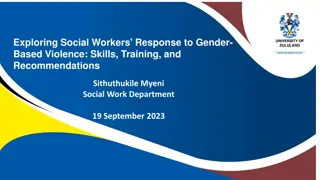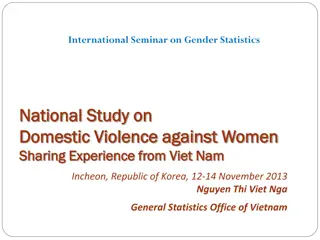Exploring Intra-Household Gender Dynamics and Domestic Violence Impacts of Covid-19 in Mauritius
Delve into the social implications of Covid-19 on gender dynamics within households in Mauritius through a webinar by Dr. Aveeraj Peedoly. The presentation focuses on two main themes: the incidence of domestic violence and the distribution of care and domestic responsibilities by gender. Key findings reveal insights on the extent of domestic violence during lockdown, highlighting the various perpetrators of violence against female respondents. Utilizing both quantitative and qualitative data sets, this research sheds light on critical areas that necessitate further investigation.
Download Presentation

Please find below an Image/Link to download the presentation.
The content on the website is provided AS IS for your information and personal use only. It may not be sold, licensed, or shared on other websites without obtaining consent from the author. Download presentation by click this link. If you encounter any issues during the download, it is possible that the publisher has removed the file from their server.
E N D
Presentation Transcript
Webinar: Social Implications of Covid-19 in Mauritius Intra-Household Gender Dynamics By Dr Aveeraj Peedoly Mauritius Research and Innovation Council Webinar: 21Jan 2021
Outline of Presentation: Focus on Gender Relations within the HH 2 specific Themes: The Data Sets i. Incidence of DV more specifically Intimate Partner Violence Key findings and Insights Reflections & Pointers towards areas that require further research. ii. Distribution of care and domestic responsibilities by gender
Modules on: Quantitative SEIA National Household Survey Instrument (n=400) SEIA Households in Extreme Poverty Survey Instrument (n=70) Enabled Capture of Prevalence/scale Domestic Violence Time Use including self-reported distribution of domestic responsibilities Data Sets Quantitative Qualitative Qualitative FGDs and Semi-directive Interviews with diverse stakeholders and opinion leaders Official Statistics (Enabled Complementarity/Further insights/Sense- making Ministry of Gender Equality Police Statistics Mauritius
Findings on extent of Domestic Violence during Lockdown SEIA National HH Survey SEIA HH in extreme poverty (DV during lockdown) Indicative Baseline for comparative purposes MRC/UNDP (2010) Question (DV during lockdown) (DV over last Reference year) 3.9% Experience of Some sort of violence at home Experience of physical assault by female respondents Experience of some sort of violence by male respondents 4.5% 9% 7.4% 9% 5.9% 1.5% - 1.9%
Violence onto female respondent by her relationship with perpetrator The Chart based on data from SEIA National HH Survey shows a breakdown of the perpetrators of violence against the female respondents highlighting that while Intimate Partner Violence accounted for 73% of domestic violence as a classic gender-based phenomenon, in no less than 27% of cases, violence has been perpetrated by grand-children (13%); children (7%); mother-in-law (7%). Spouse Grand child Living partner Mother in law Son/daughters 7% 7% 13% 60% 13%
Failure to report: Tip of the Iceberg? Victims, particularly the majority of female victims, did not report to the authorities, in part due to the feeling of shame and fear of reprisals from the abuser. Majority (62.5%) informed other people within the community including close relatives and neighbours, and 37.5% did not inform anyone. (comparable for both surveys)
Official Statistics During the lockdown period 20 March to 30 May 2020, a total number of 520 cases were officially reported of which some 93% were female victims. 111 female survivors even had to leave the conjugal roof during the lockdown. 300 280 250 203 212 219 231 217 212 211 209 200 193 190 187 187 165 174 179 177 171 168 171 177 170 160 155 152 150 140 140 136 109 100 50 - May-18 Jun-18 May-19 Jun-19 May-20 Nov-18 Nov-19 Mar-18 Jul-18 Aug-18 Sep-18 Mar-19 Jul-19 Aug-19 Sep-19 Mar-20 Jan-18 Dec-18 Jan-19 Dec-19 Jan-20 Feb-18 Feb-19 Feb-20 Apr-18 Apr-19 Apr-20 Oct-18 Oct-19 Situation Necessitated interventions: Harmonious Families Sensitisation Campaign by Min of GE Television Campaign by NGOs and Opinion Leaders to denounce DV
Causes/Profile Avenues for further research Some insights from qualitative approach Some of the cases reported at the PFPU were not new to the system Many in the lower-income groups where the pressure of coping was even higher. However, there were also many new cases including among civil servants Home under lockdown is like a pressure cooker, with all the ingredients for violence to erupt anytime Anonymous Police woman Stretching of Emotional, economic and social coping abilities Cluster of risk factors and triggers e.g: Loss of revenue/depletion of savings/restrictions of movement.
Findings: Distribution of Care and Domestic Responsibilities The lockdown set in motion, several transitional behaviors and practices to adjust to confinement. Generally, both women and men reported spending more time than usual on domestic and care responsibilities, leisure and personal and/or household activities. However, several traditional gendered roles mainly domestic chores remained skewed towards women.
Salient Points A majority of respondents (an average of some 72% for both males and females) have stated that they have spent more or significantly more household quality time, although some 24% of women stated that arguing in household was more (including 9% significantly more).
Women: Healthier Lifestyles during Women: Healthier Lifestyles during confinement? confinement? Unhealthy practices such as drinking alcohol and smoking cigarettes were also more pronounced among men. Only 6 % of female respondents stated that they have consumed more alcohol than their male counterparts (20% including 7% significantly more). 43% of women report that they have engaged more in exercises than prior to lockdown. This compares favourably with only 32% for their spouses. Likewise, increases in cigarette smoking among women have been marginal as opposed to men as it is reported that 19% of males have spent more time smoking.
Women and Men: Similar Time use on Women and Men: Similar Time use on personal activities? personal activities? Looking at such aspects as me-time by gender of respondent, at first sight there seem to be no major differences to report. Such activities as : use of social media, talking online/phone, watching TV, indulging in hobby, show that both men and women have spent more time in these activities and there are rather similar levels of indulgence by gender.
Domestic Chores and Preparing Meals These same respondents state that their spouses spent comparatively less time on this task. In effect, only 8% state that their husbands spent significantly more time preparing meals and 30% state that their husbands spent more time on this task. Traditional domestic chores and meal preparation disproportionately women. 58% of married female respondents state that they have spent more (37%) or significantly more (21%) on household chores as compared to 40% for their husbands. 62% of married female respondents for instance state lockdown they have spent more time in preparing meals including 20% who have stated significantly more. roles of have fallen on that during
Caring for dependents Caring for dependents Rather similarly 36% of female respondents that they have spent more time on care responsibilities compared to 26% for their husbands. state
Support towards childrens education Support towards children s education Female tended husbands in helping the kids in their education. 38 % of female respondents have spent more (23%) or significantly more (15%) time with their kids education. respondents to outdo have their In inequalities in the distribution of household tasks are not surprising. Latest time use survey data from Statistics Mauritius Living Conditions Survey 2019, indicate that women spend on average 2.2 hours more than men on domestic tasks on a daily basis. many ways, these In comparison, only 8% of their husbands have spent significantly more time with their kids education while 17% had spent more time.
Reflections and Pointers towards further areas of research Limitations of the data Gender Implications on HH where there have been job losses Methodological RSA V/S customized questionnaire Reference Period Lockdown in retrospect but in many households the impacts may be lasting longer
Whole Agenda for Academic and Applied Research in context of COVID Access and Control over HH resources by Gender/ Feminisation of Poverty Household as a site of cooperation and conflict Differential Coping and Livelihood Strategies by Gender Impacts on Boys v/s Girls in HH Affected by Job loss of income earners Challenges of tackling domestic violence Work from Home and Gender Implications
Thank you Q&A


























